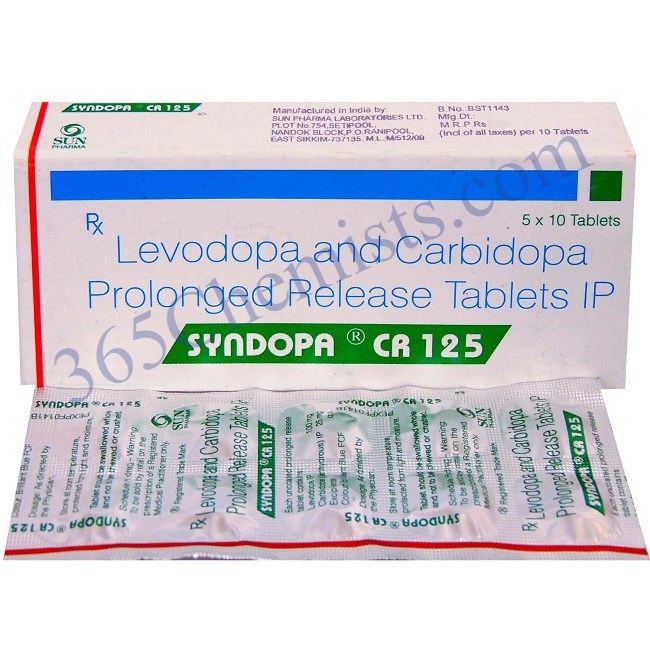Syndopa CR 125 Tablet
Syndopa Cr Tablet contains a combination of Levodopa and Carbidopa. It is used for the treatment of Parkinson’s disease. Parkinson’s disease is characterised by tremors, stiffness and unsteadiness. Avoid taking this medicine with heavy meals. Nausea and twitches are its most common side effects. These are temporary and disappear on their own. If side effects persist or there is no improvement in your condition, then inform your doctor. Do not use this medicine if you are allergic to any of the components, pregnant or breastfeeding. Take this medicine with sufficient amounts of water and do not stop on your own.
Uses of Syndopa Cr Tablet
Contraindications of Syndopa Cr Tablet
-
If you are allergic to levodopa, Carbidopa or any ingredients of this medicine.
-
History of skin cancer called melanoma or the presence of moles on the skin which have not been clinically checked by a doctor.
-
If you are taking medicines for psychiatric disorders belonging to a class MAOIs like Rasagiline should be stopped at least 14 days before you start taking this medicine.
-
If you have raised pressure in eyes, a condition called narrow-angle Glaucoma.
-
If you are diagnosed with any serious mental illness.
-
If you are pregnant or planning to get pregnant or if you are a breastfeeding mother.
Side effects of Syndopa Cr Tablet
-
Uncontrolled movements
-
Nausea
-
Feeling sick
-
Dry mouth
-
Unsteadiness and confusion
-
Reduced appetite
-
Drowsiness (excessive sleepiness)
-
Delusions, hallucinations or fits
-
Discoloration of urine
-
Low blood pressure
-
Anxiety
-
Mood swings
-
Chest pain and shortness of breath
-
Allergic reactions of the skin
Related Product
Syndopa 110mg Tablet
Syndopa 275mg Tablet
Syndopa CR 250mg Tablet
Syndopa CR 125 Tablet
Syndopa Plus Tablet
Precautions and Warnings of Syndopa Cr Tablet
Pregnancy
Breast Feeding
Driving
Alcohol
Other General Warnings
-
You experience mood changes, sleep attacks or excessive sleepiness.
-
You have or had an ulcer in your stomach or intestine.
-
You have had a heart attack or heart disorder or breathing problems.
-
You have had kidney, liver or hormonal problems.
-
You have a surgery or operation due. You have a history of fits.
-
You have an eye condition called ‘glaucoma.’ You will need to have regular checks on the pressure in your eye.
Mode of Action of Syndopa Cr Tablet
How Does It Work?
-
Parkinson’s disease is characterised by stiffness, uncontrolled movement, shakiness and slow movements of the body due to lack of a chemical called dopamine.
-
Dopamine is produced naturally in the brain. Levodopa present in Syndopa Cr Tablet gets converted into dopamine and supplies sufficiently.
-
Carbidopa prevents the break-down of levodopa in the body ensuring that a higher proportion of the dose reaches the brain, where dopamine acts.
Directions for Use of Syndopa Cr Tablet
-
Take Syndopa Cr Tablet as a whole with a sufficient amount of water.
-
Try to take it at a fixed time every day as advised by your doctor.
-
Do not skip the doses even if you feel better.
Interactions of Syndopa Cr Tablet
Interactions with other medicines
-
Tell your doctor if you are taking any other medicine, especially to treat Parkinson’s disease.
-
If you are taking any iron preparations, as it may need a dose adjustment.
-
Medicine for any mental illness may cause a worsening of side effects; the dose needs to be adjusted.
-
The patient’s response should be monitored when administered with anticholinergic preparations like Benzatropine and Procyclidine.
-
You may experience low blood pressure on standing suddenly from a lying posture if you are on antihypertensives.
-
Medicine for tuberculosis and epilepsy may require a change in the dosage.
Interactions with food items
Storage and disposal of Syndopa Cr Tablet
-
Store at a temperature below 30°C.
-
Keep it out of the reach of children and pets.
Dosage of Syndopa Cr Tablet
Overdose
If you happen to take more than the prescribed dose of this medicine, report to the nearest hospital immediately. It may cause rapid, irregular heartbeats, uncontrolled muscular twitching and loss of consciousness.












